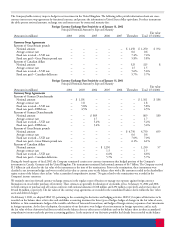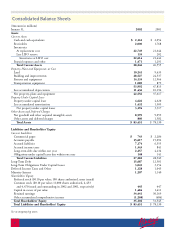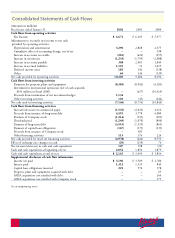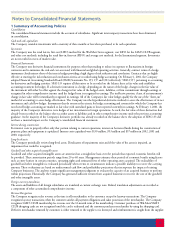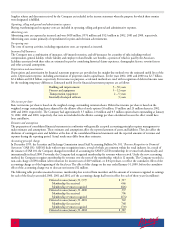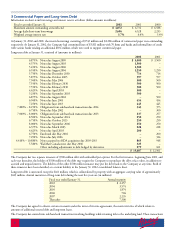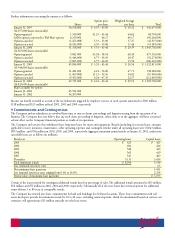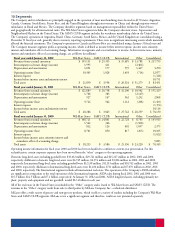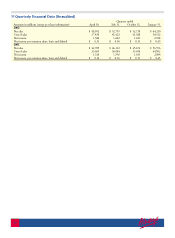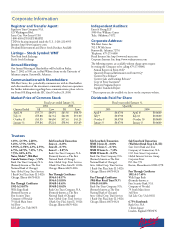Walmart 2002 Annual Report Download - page 34
Download and view the complete annual report
Please find page 34 of the 2002 Walmart annual report below. You can navigate through the pages in the report by either clicking on the pages listed below, or by using the keyword search tool below to find specific information within the annual report.
32
were accounted for as financings and are included in long-term debt and the annual maturity schedule on the previous page. The resulting
obligations are amortized over the lease terms. Future minimum lease payments for each of the five succeeding years as of January 31, 2002
are (in millions):
Fiscal year ended January 31, Minimum payments
2003 $ 98
2004 93
2005 130
2006 94
2007 92
Thereafter 408
At January 31, 2002 and 2001, the Company had letters of credit outstanding totaling $1,578 million and $1,129 million, respectively.
These letters of credit were issued primarily for the purchase of inventory.
In July 2001, the Company filed a shelf registration statement with the United States Securities and Exchange Commission under which
it could issue up to a total of $6 billion in debt securities. During fiscal 2002 the Company issued $3.5 billion under this shelf registration
statement. In March 2002, the Company sold notes totaling $500 million pursuant to the shelf registration statement. These notes
bear interest at 4.15% and are due in June 2005. The proceeds from the sale of these notes will be used for general corporate purposes,
which could include financing the repurchase of shares of the Company’s stock pursuant to its existing stock repurchase program. After
consideration of this debt issuance and the $3.5 billion debt issued during fiscal 2002, the Company is permitted to sell up to $2 billion
of public debt under the shelf registration statement.
4 Financial Instruments
The Company uses derivative financial instruments for hedging and non-trading purposes to manage its exposure to interest and foreign
exchange rates. Use of derivative financial instruments in hedging programs subjects the Company to certain risks, such as market and
credit risks. Market risk represents the possibility that the value of the derivative instrument will change. In a hedging relationship, the
change in the value of the derivative is offset to a great extent by the change in the value of the underlying hedged item. Credit risk related
to derivatives represents the possibility that the counterparty will not fulfill the terms of the contract. Credit risk is monitored through
established approval procedures, including setting concentration limits by counterparty, reviewing credit ratings and requiring collateral
(generally cash) when appropriate. The majority of the Company’s transactions are with counterparties rated A or better by nationally
recognized credit rating agencies.
Adoption of FASB 133
On February 1, 2001, the Company adopted Financial Accounting Standards Board Statement No. 133, “Accounting for Derivative and
Hedging Activities” (FASB 133), as amended. Because most of the derivatives used by the Company at the date of adoption were designated
as net investment hedges, the fair value of these instruments was included in the balance sheet prior to adoption of the standard. As a result,
the adoption of this standard did not have a significant effect on the consolidated financial statements of the Company.
Interest rate instruments
The Company enters into interest rate swaps to minimize the risks and costs associated with its financing activities. Under the swap
agreements, the Company pays variable rate interest and receives fixed interest rate payments periodically over the life of the instruments.
The notional amounts are used to measure interest to be paid or received and do not represent the exposure due to credit loss. All of the
Company’s interest rate swaps are designated as fair value hedges. In a fair value hedge, the gain or loss on the derivative instrument as well as
the offsetting gain or loss on the hedged item attributable to the hedged risk are recognized in earnings in the current period. Ineffectiveness
results when gains and losses on the hedged item are not completely offset by gains and losses in the hedge instrument. No ineffectiveness
was recognized in fiscal 2002 related to these instruments. The fair value of these contracts is included in the balance sheet in the line titled
“Other assets and deferred charges.”
Net Investment instruments
At January 31, 2002, the Company is a party to cross-currency interest rate swaps which hedge its net investment in the United Kingdom.
The agreements are contracts to exchange fixed rate payments in one currency for fixed rate payments in another currency. During the fourth
quarter of fiscal 2002, the Company terminated cross-currency instruments that hedged portions of the Company’s net investments in
Canada, Germany and the United Kingdom. These instruments had notional amounts of $6.7 billion. The Company received $1.1 billion
in cash related to the fair value of the instruments at the time of the terminations. Prior to the terminations, these instruments were classified
as net investment hedges and were recorded at fair value as current assets on the balance sheet with a like amount recorded on the balance
sheet shareholders’ equity section in the line “other accumulated comprehensive income.” No gain related to the terminations was recorded
in the Company’s income statement. The fair value of these contracts is included in the balance sheet in the line titled “Other assets and
deferred charges.”
Cash Flow Hedge
The Company has entered into a cross-currency interest rate swap related to $325 million of U.S. dollar denominated debt securities issued
by a Canadian subsidiary of the Company during fiscal 2002. The swap is designated as a cash flow hedge of foreign currency exchange risk.
No ineffectiveness was recognized during fiscal 2002 related to this instrument. The Company expects that the amount of gain existing in


